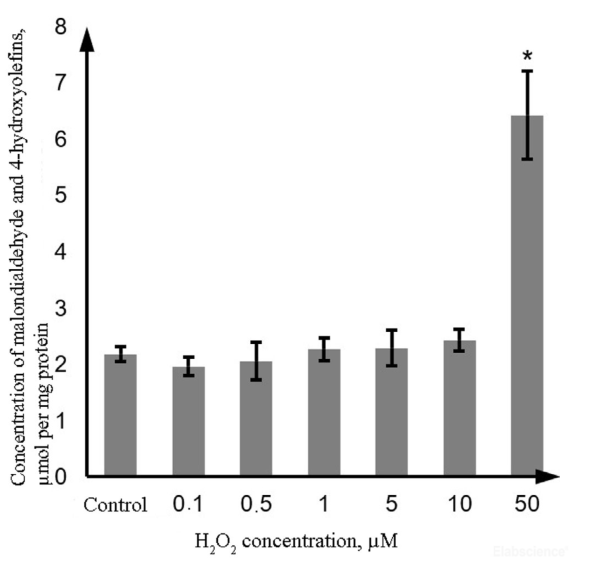Lipid Peroxide (LPO) Colorimetric Assay Kit
SKU: E-BC-K176-M-96
Lipid Peroxide (LPO) Colorimetric Assay Kit
| SKU # | E-BC-K176-M |
| Detection Instrument | Microplate reader (580-590 nm) |
| Detection method | Colorimetric method |
Product Details
Properties
| Synonyms | LPO |
| Sample Type | Serum, plasma, urine, tissue |
| Sensitivity | 0.70 μmol/L |
| Detection Range | 0.70-80 μmol/L |
| Detection Method | Colorimetric method |
| Assay type | Quantitative |
| Assay time | 90 min |
| Precision | Average inter-assay CV: 3.500% | Average intra-assay CV: 3.100% |
| Other instruments required | Water bath, Centrifuge, Micropipettor, Vortex mixer |
| Other reagents required | Double distilled water, PBS (0.01 M, pH 7.4) |
| Storage | 2-8℃ |
| Valid period | 12 months |
Images
A V Shchulkin et al investigate the function of P-glycoprotein in decreasing cell membranes permeability during oxidative stress. Lipid peroxide (LPO) level in human cell was determined using LPO colorimetric assay kit (E-BC-K176-M).

LPO level was induced significantly after treated with H2O2 of 50 μM. (*P<0.05)
Dilution of Sample
It is recommended to take 2~3 samples with expected large difference to do pre-experiment before formal experiment and dilute the sample according to the result of the pre-experiment and the detection range ( 0.70-80 μmol/L).
The recommended dilution factor for different samples is as follows (for reference only):
| Sample type | Dilution factor |
| Human serum | 1 |
| Human plasma | 1 |
| Urine | 1 |
| 10% Rat kidney tissue homogenization | 1 |
| 10% Rat liver tissue homogenization | 1 |
Note: The diluent is PBS (0.01 M, pH 7.4).
Detection Principle
With 45℃ incubation for 60 min, one molecule of LPO react with two molecule of chromogenic reagent, to produce a stable chromophore which have the maximum absorption peak at 586nm. The content of LPO in samples can be calculated by standard curve or calculation formula.
Kit Components & Storage
| Item | Component | Size 1(48 T) | Size 2(96 T) | Storage |
| Reagent 1 | Substrate Stock Solution | 30 mL × 1 vial | 60 mL × 1 vial | 2-8°C, 12 months, shading light |
| Reagent 2 | Diluent | 20 mL × 1 vial | 20 mL × 1 vial | 2-8°C, 12 months, shading light |
| Reagent 3 | Acid Reagent | 10 mL × 1 vial | 20 mL × 1 vial | 2-8°C, 12 months, shading light |
| Reagent 4 | 100 μmol/L Standard | 6 mL ×1 vial | 6 mL ×1 vial | 2-8°C, 12 months, shading light |
| Microplate | 96 wells | No requirement | ||
| Plate Sealer | 2 pieces | |||
Note: The reagents must be stored strictly according to the preservation conditions in the above table. The reagents in different kits cannot be mixed with each other. For a small volume of reagents, please centrifuge before use, so as not to obtain sufficient amount of reagents.
Technical Data:
Parameter:
Intra-assay Precision
Three human serum samples were assayed in replicates of 20 to determine precision within an assay. (CV = Coefficient of Variation)
| Parameters | Sample 1 | Sample 2 | Sample 3 |
| Mean (μmol/L) | 5.60 | 34.50 | 66.00 |
| %CV | 3.5 | 2.9 | 2.9 |
Inter-assay Precision
Three human serum samples were assayed 20 times in duplicate by three operators to determine precision between assays.
| Parameters | Sample 1 | Sample 2 | Sample 3 |
| Mean (μmol/L) | 5.60 | 34.50 | 66.00 |
| %CV | 3.2 | 3.5 | 3.8 |
Recovery
Take three samples of high concentration, middle concentration and low concentration to test the samples of each concentration for 6 times parallelly to get the average recovery rate of 99%
| Standard 1 | Standard 2 | Standard 3 | |
| Expected Conc. (μmol/L) | 7.5 | 26.4 | 48.5 |
| Observed Conc. (μmol/L) | 7.6 | 26.1 | 47.0 |
| Recovery rate (%) | 101 | 99 | 97 |
Sensitivity
The analytical sensitivity of the assay is 0.70 μmol/L. This was determined by adding two standard deviations to the mean O.D. obtained when the zero standard was assayed 20 times, and calculating the corresponding concentration.
Standard Curve
As the OD value of the standard curve may vary according to the conditions of the actual assay performance (e.g. operator, pipetting technique or temperature effects), so the standard curve and data are provided as below for reference only.
| Concentration (μmol/L) | 0 | 5 | 10 | 20 | 30 | 40 | 50 | 80 |
| Average OD | 0.079 | 0.140 | 0.236 | 0.389 | 0.563 | 0.722 | 0.903 | 1.357 |
| Absoluted OD | 0 | 0.061 | 0.157 | 0.31 | 0.484 | 0.643 | 0.824 | 1.278 |



